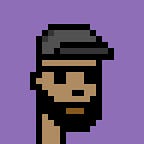AB 101: Historical Figures in Generative Art — Georg Nees
Georg Nees is one of the primary innovators of computer art, digital art, and generative art. Along with Frieder Nake and A. Michael Noll, Nees is considered one of the “3N” computer pioneers in digital graphics in the 1960s.
Nees was a German mathematician and academic who found his way to computer art by studying mathematics, physics, and philosophy. Ultimately, studying under Max Bense at the University of Stuttgart, he earned his Ph.D. in Philosophy and wrote the first book on generative computer graphics called Generative Computergraphik.
It’s important to say a brief word here on Bense. Understood broadly, Bense’s work was primarily concerned with bridging the gap between philosophy and mathematics. For Bense, things like language, beauty, aesthetics, and psychology were underpinned by objective reality. One that he called Existential Rationalism. He coined the term Existential Rationalism to describe the fundamental components of language that provide a framework to understand literature, departing from a framework based on meaning. The application of objective rationality to traditionally subjective structures of meaning was a repeating theme in Bense’s work.
Related to Existential Rationalism, Bense’s information aesthetics took aim at Art. Information aesthetics aims to understand the aesthetic object itself without “art historian chatter.” He did this by framing Art creation, consumption, and criticism as an output based on a series of procedures that could be computed. This is a radical claim from the common understanding of Art, and no surprise that Nees was drawn to study under Bense.
From 1951–85, Nees worked as an industrial mathemetician at Siemens. His academic background in mathematics translated into creating production quality computer programs as early as 1959. During his time at Siemens, they acquired a Zuse Graphomat Z64, and Nees was tasked with figuring out a way to make it useful. The Z64 was a punched taped controlled automatic drafting table (think plotter), and Nees ended up creating multiple graphic libraries to control the Z64 using the ALGOL language. In these early days, Nees even experimented with randomness to create graphics with the machine.
Nees was the first generative computer graphic artist to show their work in an exhibition in 1965 at Stuttgart College titled Computer Graphik. Bense invited Nees to show his digital compositions alongside works that broadly aligned with Bense’s radical rationality. Other pieces included text and typography, but procedurally generated graphics uniquely captured the spirit of Bense’s information aesthetics — that is — a set of an objective, rule-based framework to create meaningful pieces of graphic art.
Nees would go on to display work in 30+ exhibitions, write five books, author 15+ professional and academic papers, and be included in collections around the world — including ZKM Center for Art and Media Karlsruhe, Abteiberg Museum, Kunsthalle Bremen, and Victoria and Albert Museum.
Major Works
Perhaps the most iconic piece by Nees, Gravel shows the delicate balance between order and disorder in generative art. This piece is part of the Victoria and Albert Museum’s collection in London.
Polygon of 23 Vertices was shown in the Generative Computergrafik 1965 exhibit at the University of Stuttgart and later published in rot19.
Gallery label from Victoria and Albert Museum:
Chance and Control: Art in the Age of Computers (2018) GEORG NEES (1926–2016) Untitled Published by Werkstatt Edition Kroll, Germany, 1970 This screenprint was produced from a unique plotter drawing. The plotter was operated by feeding punched tape into a computer that used the instructions to direct a pen across a drawing surface. As the computer had no screen, Nees would not have been able to fully anticipate the appearance of the resulting drawing.
Achsenparalleler Irrweg is currently on display at ZKM | Center for Art and Media Karlsruhe.
Material / Technique:
Computer-generated graphic ; plotter drawing; computer: Siemens digital computer 2002, programming language: ALGOL, output device: ZUSE Graphomat Z 64; ink on paper
Physical description by Victoria and Albert Museum:
Orange and black screenprint, mounted on board, from a plotter drawing. This print depicts line drawings of two globe-like forms, one inside the other.
Interview
Watch a brief interview where Nees talks about his first exhibition in 1965 and Max Bense. He even recounts the classic conversation in which an artists ask if he can make a computer draw as an artist, and he replied:
Yes, of course, I can do this. Under one condition: you must tell me how you draw.
